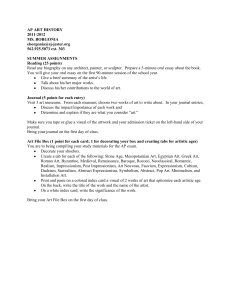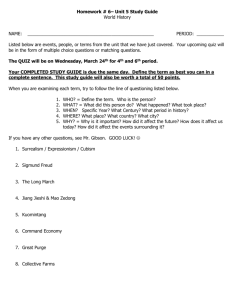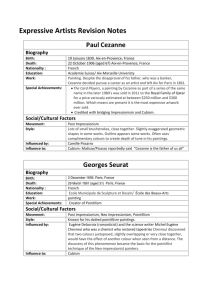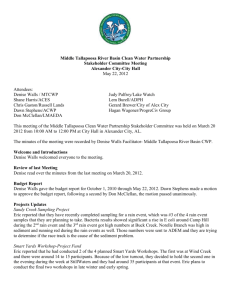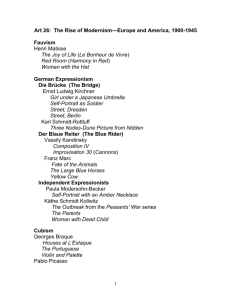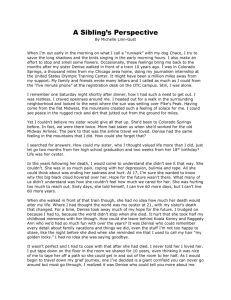Modern art timeline - sec3aep
advertisement
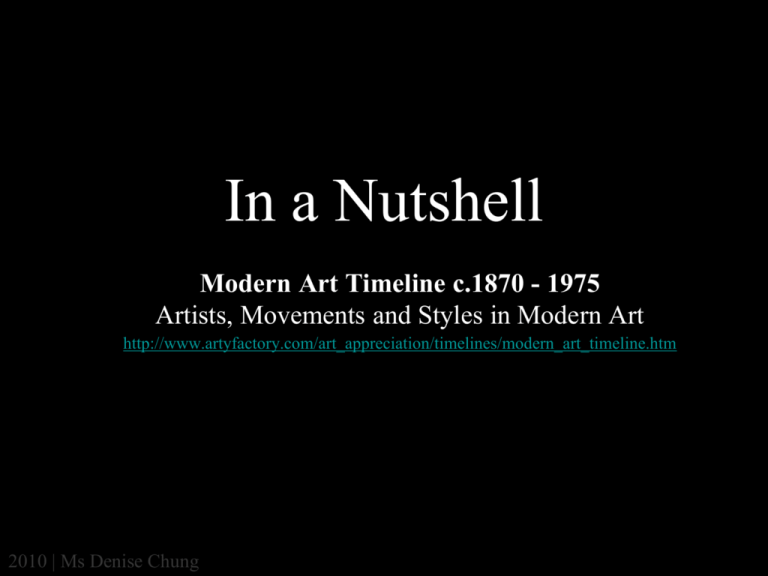
In a Nutshell Modern Art Timeline c.1870 - 1975 Artists, Movements and Styles in Modern Art http://www.artyfactory.com/art_appreciation/timelines/modern_art_timeline.htm 2010 | Ms Denise Chung Impressionism c.1870-1890 Claude Monet 1840-1926 Impressionism is the name given to a colorful style of painting in France at the end of the 19th century. The Impressionists searched for a more exact analysis of the effects of colour and light in nature. They sought to capture the atmosphere of a particular time of day or the effects of different weather conditions. They often worked outdoors and applied their paint in small brightly coloured strokes which meant sacrificing much of the outline and detail of their subject. Impressionism abandoned the conventional idea that the shadow of an object was made up from its colour with some brown or black added. 2010 | Ms Denise Chung Rouen Cathedral - in full sunlight 1893/4 Louvre, Paris Impressionism c.1870-1890 Claude Monet 1840-1926 Instead, the Impressionists enriched their colours with the idea that a shadow is broken up with dashes of its complementary colour. Among the most important Impressionist painters were Claude Monet, Pierre Auguste Renoir,Edgar Degas, Camille Pissarro, Alfred Sisleyand Henri de Toulouse Lautrec. Overview lecture on Impressionism and PostImpressionism 2010 | Ms Denise Chung Impression Sunrise (oil on canvas, 1872) Musée Marmottan, Paris The Impressionists (BBC Drama) The Impressionists is a 3 part factual drama from the BBC, which reconstructs the origins of the Impressionist art movement. See it on Youtube! Episode 1: Part 1 | Part 2 | Part 3 | Part 4 | Part 5 | Part 6 Episode 2: Part 1 | Part 2 | Part 3 | Part 4 | Part 5 | Part 6 Episode 3: Part 1 | Part 2 | Part 3 | Part 4 | Part 5a | Part 5b | Part 6 2010 | Ms Denise Chung Post Impressionism c.1885-1905 Vincent Van Gogh 1853-90 The Post Impressionists were a few independent artists at the end of the 19th century who rebelled against the limitations of Impressionism to develop a range of personal styles that influenced the development of art in the 20th century. The major artists associated with Post Impressionism were Paul Cézanne, Paul Gauguin, Vincent Van Gogh and Georges Seurat. Cézanne was an important influence on Picasso and Braque in their development of Cubism. Van Gogh's vigorous and vibrant painting technique was one of the touchstones of both Fauvism and Expressionism, while Gauguin's symbolic color and Seurat's pointillist technique were an inspiration to Les Fauves. Understand post-impressionism with information from an art historian, critic and curator in this free video on art. 2010 | Ms Denise Chung Café Terrace at Night, 1888 Kröller-Müller Museum Fauvism c.1905-10 Henri Matisse 1869-1954 Fauvism was a joyful style of painting that delighted in using outrageously bold colours. It was developed in France at the beginning of the 20th century by Henri Matisse and André Derain. The artists who painted in this style were known as 'Les Fauves' (the wild beasts), a title that came from a sarcastic remark in a review by the art critic Louis Vauxcelles. Les Fauves believed that colour should be used at its highest pitch to express the artist's feelings about a subject, rather than simply to describe what it looks like. Fauvist paintings have two main characteristics: extremely simplified drawing and intensely exaggerated colour. They were a major influence on the German Expressionists. 2010 | Ms Denise Chung The Open Window, Collioure, 1905 The National Gallery of Art, Washington Cubism c.1907-15 Pablo Picasso 1881-1973 Cubism was invented around 1907 in Paris by Pablo Picasso and Georges Braque. It was the first abstract style of modern art. Cubist paintings ignore the traditions of perspective drawing and show you many views of a subject at one time. The Cubists believed that the traditions of Western art had become exhausted and to revitalize their work, they drew on the expressive energy of art from other cultures, particularly African art. There are two distinct phases of the Cubist style: Analytical Cubism (pre 1912) and Synthetic Cubism(post 1912). 2010 | Ms Denise Chung Les Demoiselles d'Avignon. Oil on Canvas (244 x 234 cm) Museum of Modern Art, New York Cubism c.1907-15 Pablo Picasso 1881-1973 Cubism influenced many other styles of modern art including Expressionism, Futurism, Orphism, Vorticism, Suprematism, Constructivism and De Styjl. Other notable artists associated with Cubism were Juan Gris, Fernand Leger, Robert Delaunay, Albert Gleizes, Jean Metzinger, Louis Marcoussis and Marie Laurencin. Ambroise Vollard, 1915 Pushkin Museum of Fine Art 2010 | Ms Denise Chung German Expressionism c.1905-25 Ernst Ludwig Kirchner 1880-1938 German Expressionism is a style of art that is charged with an emotional or spiritual vision of the world. The expressive paintings of Vincent Van Gogh and Edvard Munch influenced the German Expressionists. Expressionism was a militant spirit. The German Expressionists saw themselves as revolutionary shock troops with art as their weapon. They wanted to liberate themselves from the repressive right-wing social and political establishment in pre WW1 Germany, but they were also desperate to free their art from the shackles of French painting which had monopolised modern art since Impressionism. Chief Educator Barbara Brown from Milwaukee Art Museum explains what German Expressionism is about. 2010 | Ms Denise Chung The Red Tower at Halle, 1915 Folkwang Museum, Essen German Expressionism c.1905-25 Wassily Kandinsky 1866 - 1944 They also drew their inspiration from German Gothic and 'primitive art'. The Expressionists were divided into two factions: Die Brücke and Der Blaue Reiter. Die Brücke (The Bridge) was an artistic community of young artists in Dresden who aimed to overthrow the conservative traditions of German art. Ernst Ludwig Kirchner and Karl SchmidtRottluff were two of its founding members. Der Blaue Reiter (the Blue Rider) was a group of artists whose publications and exhibitions sought to find a common creative ground between the various Expressionist art forms. Kandinsky, Marc and Macke were among its founding members. 2010 | Ms Denise Chung "Der Blaue Reiter" (The Blue Rider), painted 1903 Abstract Art c.1907 onwards Georges Braque 1882-1963 Abstract art is a generic term that describes two different methods of abstraction: 'semi abstraction' and 'pure abstraction'. The word 'abstract' means to withdraw part of something in order to consider it separately. In Abstract art that 'something' is one or more of the visual elements of a subject: its line, shape, tone, pattern, texture, or form. Semi-Abstraction is where the image still has one foot in representational art, (see Cubism and Futurism). It uses a type of stylisation where the artist selects, develops and refines specific visual elements (eg. line, color and shape) in order to create a poetic reconstruction or simplified essence of the original subject. Violin and Pitcher, 1910 (detail) Kunstmuseum, Basel 2010 | Ms Denise Chung Abstract Art c.1907 onwards Kazimir Malevich 1879-1935 Pure Abstraction is where the artist uses visual elements independently as the actual subject of the work itself. (see Suprematism,De Styjl and Minimalism). Although elements of abstraction are present in earlier artworks, the roots of modern abstract art are to be found in Cubism. Among other important abstract styles that developed in the 20th century are Orphism, Rayonism, Constructivism, Tachisme, Abstract Expressionism, and Op Art. Suprematism, 1915 Stedelijk Museum, Amsterdam 2010 | Ms Denise Chung Futurism c.1909-1914 Giacomo Balla 1871-1959 Futurism was a revolutionary Italian movement that celebrated modernity. The Futurist vision was outlined in a series of manifestos that attacked the long tradition of Italian art in favour of a new avant-garde. They glorified industrialization, technology, and transport along with the speed, noise and energy of urban life. The Futurists adopted the visual vocabulary of Cubism to express their ideas - but with a slight twist. In a Cubist painting the artist records selected details of a subject as he moves around it, whereas in a Futurist painting the subject itself seems to move around the artist. The Rhythm of the Violinist (detail), 1912 Estorick Collection, London 2010 | Ms Denise Chung Futurism c.1909-1914 Umberto Boccioni 1882–1916 The effect of this is that Futurist paintings appear more dynamic than their Cubist counterparts. Futurism was founded in 1909 by the poet Filippo Tommas Marinetti and embraced the arts in their widest sense. The main artists associated with the movement were Umberto Boccioni, Giacomo Balla and Gino Severini. The Futurist Manifesto Unique Forms of Continuity in Space, 1913 2010 | Ms Denise Chung De Styjl c.1917-1931 Piet Mondrian 1872-1944 De Styjl was a Dutch 'style' of pure abstraction developed by Piet Mondrian, Theo Van Doesburg and Bart van der Leck. Mondrian was the outstanding artist of the group. He was a deeply spiritual man who was intent on developing a universal visual language that was free from any hint of the nationalism that led to the Great War. Mondrian gradually refined the elements of his art to a grid of lines and primary colors which he configured in a series of compositions that explored his universal principles of harmony. He saw the elements of line and color as possessing counteracting cosmic forces. Composition with White and Yellow, 1935-42 Christies, New York 2010 | Ms Denise Chung De Styjl c.1917-1931 Piet Mondrian 1872-1944 Vertical lines embodied the direction and energy of the sun's rays which were countered by horizontal lines relating to the earth's movement around it. He saw primary colors through the same cosmic tinted spectacles: yellow radiated the sun's energy; blue receded as infinite space and red materialized as blue and yellow met. Mondrian's style which he also called 'NeoPlasticism' was inspired by the Theosophical beliefs of the mathematician and philosopher, M.H.J. Schoenmaekers. Composition with Yellow, Blue and Red Currently held as part of the Tate Collection 2010 | Ms Denise Chung Dada c.1916-1922 Raoul Hausmann 1886-1971 Dada was not a style of art like Fauvism or Cubism. It was a form of artistic anarchy born out of disgust for the social, political and cultural establishment of the time which it held responsible for Europe's descent into World War. Dadaism was an ‘anti art’ stance as it was intent on destroying the artistic values of the past. The aim of Dada was to create a climate in which art was alive to the moment and not paralysed by the corrupted traditions of the established order. Dada’s weapons in the war against the art establishment were confrontation and provocation. Tatlin at Home, 1920 Moderna Museet, Stockholm 2010 | Ms Denise Chung Dada c.1916-1922 Marcel Duchamp 1887-1968 They confronted the artistic establishment with the irrationality of their collages and assemblages and provoked conservative complacency with outrageous actions at their exhibitions and meetings. The movement started in Zurich and spread as far as New York. Marcel Duchamp, Raoul Hausmann, Jean Arp and Kurt Schwitters were among the best of the Dada artists. Photograph of Marcel Duchamp's "Fountain". 2010 | Ms Denise Chung Surrealism c.1924-1939 René Magritte 1898-1967 Surrealism was the positive outcome from Dada's negativity. Its aim as outlined in the First Surrealist Manifesto of 1924, was to liberate the artist's imagination by tapping into the unconscious mind to discover a 'superior' reality - a surreality. To achieve this the Surrealists drew upon the images of dreams, the unpredictable effects from combining disassociated images, and the technique of 'pure psychic automatism', a spontaneous form of drawing without the conscious control of the mind. Time Transfixed, 1938 Art Institute of Chicago 2010 | Ms Denise Chung Surrealism c.1924-1939 Salvador Dalí 1904-1989 The look of Surrealist art was inspired by the irrational juxtaposition of images in Dada collages, the dreamlike art of Giorgio de Chirico, and both 'primitive' and 'outsider' art. The most influential of the Surrealist artists were Max Ernst, Joan Miró, Salvador Dali and René Magritte. The movement broke up at the outbreak of war in 1939 when several of the Surrealists left Europe for New York where they had a formative influence on the development of Abstract Expressionism. 2010 | Ms Denise Chung The Persistence of Memory 1931. Oil on canvas, 9 1/2 x 13" (24.1 x 33 cm). Modern Masters (BBC Documentary) Unfortunately, only one episode, on Salvador Dali, can be found online. Salvador Dali: Part 1 | Part 2 | Part 3 | Part 4 | Part 5 | Part 6 Modern Masters is a four-part television series detailing the life and work of four giants of 20th century art: Henri Matisse; Pablo Picasso; Salvador Dali and Andy Warhol. During the course of the series, presenter and journalist, Alastair Sooke, explores why these artists are considered so important and examines how their influence can still be seen in our world today. 2010 | Ms Denise Chung
